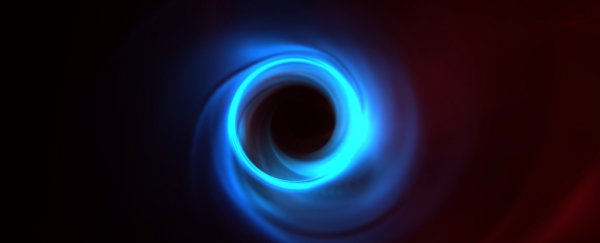General relativity is about as strong a theory as there is. Test after test has been thrown at it, and it just keeps on holding up. Even so, wiggle room remains. Although the results of these tests have been consistent with general relativity, they've also failed to rule out a number of modified versions offered as alternatives.
Now, the supermassive black hole at the heart of a galaxy 55 million light-years away has provided relativity with its most stringent test yet. Yes, it's M87*, the Universe's most photogenic black hole, and the Event Horizon Telescope collaboration has probed the region around it to make general relativity 500 times more robust, incredibly enough.
While general relativity is great for predicting and understanding gravitational interactions, it's mathematically incompatible with quantum mechanics; the rules that help us model non-gravitational interactions between objects.
This has led scientists to look for modifications and even alternatives to general relativity. The goal is a unified theory that describes all of the forces in the same manner. So any proposed modifications to current theories that attempt to do that, while failing to be consistent with what we see in real life, should get the chop.
"We expect a complete theory of gravity to be different from general relativity, but there are many ways one can modify it," explained astrophysicist Dimitrios Psaltis of the University of Arizona.
"We found that whatever the correct theory is, it can't be significantly different from general relativity when it comes to black holes. We really squeezed down the space of possible modifications."
When scientists achieved, for the first time, the image of a black hole's shadow and a ring of hot material swirling around it, it gave us new ways to test general relativity. One of those was the size of the shadow.
This shadow is the dark region in the centre of the swirling mass of material, defined by the event horizon - the point at which even light speed is insufficient to attain escape velocity of the black hole's gravitational pull. This means no light can shine from a black hole. Since the effect is a gravitational one, the size of the region can be predicted under general relativity.
M87* is a supermassive black hole tipping the cosmic scales at 6.5 billion times the mass of the Sun. The mathematics of general relativity can use this mass to predict a very precise size of the dark emptiness, or shadow, where light can't escape.
When the image of the black hole was first obtained, this was one of the early tests performed - and, of course, the size of the shadow was as predicted.
"At that time, we were not able to ask the opposite question: How different can a gravity theory be from general relativity and still be consistent with the shadow size?" said astrophysicist Pierre Christian of the University of Arizona. "We wondered if there was anything we could do with these observations in order to cull some of the alternatives."
General relativity has passed several tests in the Solar System. The way the orientation of Mercury's orbit shifts around the Sun is one. The way starlight bends along the curvature of spacetime around a massive object like the Sun is another. Precise measurements of distances between planets provide yet another.
Several modifications to general relativity have also passed Solar System tests. So the team collected these Solar System-based modifications to test against M87*. Rather than actually test each one as a whole against observations, for each alternative theory of gravity, the team identified the unique characteristics that predicts a black hole's shadow.
This allowed the team to identify whether the theory is consistent with the Event Horizon Telescope observations of M87* without needing to think about other, irrelevant details. And this allowed them to effectively rule out some of the proposed modifications to general relativity.
"Using the gauge we developed, we showed that the measured size of the black hole shadow in M87* tightens the wiggle room for modifications to Einstein's theory of general relativity by almost a factor of 500, compared to previous tests in the solar system," said astrophysicist Feryal Özel of the University of Arizona.
"Many ways to modify general relativity fail at this new and tighter black hole shadow test."
That doesn't mean general relativity can't be broken, and the quest to do so continues - not because astrophysicists hate general relativity, but because each test provides new constraints and new tools for the next test - hopefully leading us ever closer to resolving the difference between general relativity and quantum mechanics.
So, general relativity hasn't broken in the strongest gravitational field it's been tested in - and by ruling out certain alternatives, the team's results show us where we can stop looking for an answer.
"We always say general relativity passed all tests with flying colours - if I had a dime for every time I heard that," Özel said.
"But it is true, when you do certain tests, you don't see that the results deviate from what general relativity predicts. What we're saying is that while all of that is correct, for the first time we have a different gauge by which we can do a test that's 500 times better, and that gauge is the shadow size of a black hole."
The Event Horizon Telescope is growing stronger. Three new telescopes have recently joined the global array, and a new observing run will be undertaken next year. This, hopefully, will provide even higher resolution images of a black hole's shadow, at which we can throw even more stringent tests.
"Together with gravitational wave observations, this marks the beginning of a new era in black hole astrophysics," Psaltis said.
The research has been published in Physical Review Letters.
